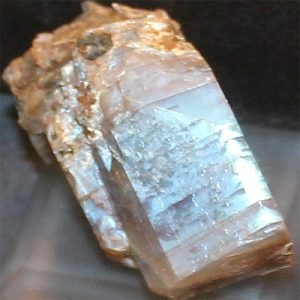Sanidine: Gemstone Information
Sanidine is a mineral belonging to the feldspar group, which is one of the most abundant mineral groups on Earth. It has a chemical composition similar to other feldspars, primarily composed of aluminum, silicon, and oxygen, with the addition of potassium. Sanidine is a high-temperature form of potassium feldspar, crystallizing at temperatures above 650°C (1,202°F). It typically occurs in igneous rocks such as granite, syenite, and trachyte, and sometimes in metamorphic rocks as well.
Physical Properties: Sanidine typically forms as prismatic crystals with a square cross-section. It often exhibits a glassy or vitreous luster and ranges in color from white to gray, pink, or yellow. Its hardness falls between 6 and 6.5 on the Mohs scale, making it moderately hard.
Occurrence and Distribution: Sanidine is commonly found in volcanic and plutonic igneous rocks. It is an essential constituent of many granite and syenite formations. Locations where sanidine can be found include the United States, Norway, Italy, Russia, and other regions with significant volcanic or igneous activity.
Industrial Applications:
Ceramics: Sanidine, like other feldspars, is widely used in the ceramic industry for its fluxing properties. It helps lower the melting point of ceramic materials, promoting the vitrification process and enhancing the strength and durability of ceramic products.
Glass Manufacturing: Sanidine can be used in glassmaking as a fluxing agent to facilitate the melting of silica sand and other raw materials. It improves the workability of the glass melt and reduces energy consumption during the manufacturing process.
Construction Materials: Sanidine-bearing rocks such as granite are commonly used as dimension stones in construction projects. These stones are prized for their aesthetic appeal, durability, and resistance to weathering, making them suitable for countertops, flooring, cladding, and other architectural applications.
Metaphysical Properties: In metaphysical and spiritual practices, sanidine is believed to possess certain properties that promote grounding, stability, and emotional balance. It is said to help dispel negative energy and foster a sense of inner peace and harmony. Some individuals use sanidine crystals for meditation, healing rituals, and chakra balancing exercises.
Health and Wellness: While there is limited scientific evidence to support any direct health benefits of sanidine, some alternative medicine practitioners suggest that it may have therapeutic properties when used in crystal healing therapies. However, these claims are largely anecdotal and not supported by rigorous scientific research.
Environmental Impact: Mining and quarrying activities associated with the extraction of sanidine-bearing rocks can have environmental implications such as habitat destruction, landscape alteration, and the generation of waste materials and pollutants. Sustainable mining practices and environmental management strategies are essential for mitigating these impacts and promoting responsible resource utilization.
In conclusion, sanidine is a versatile mineral with various industrial applications, particularly in ceramics, glass manufacturing, and construction. While it also holds significance in metaphysical practices, its primary value lies in its physical and chemical properties that contribute to the production of high-quality materials essential for numerous industries.





